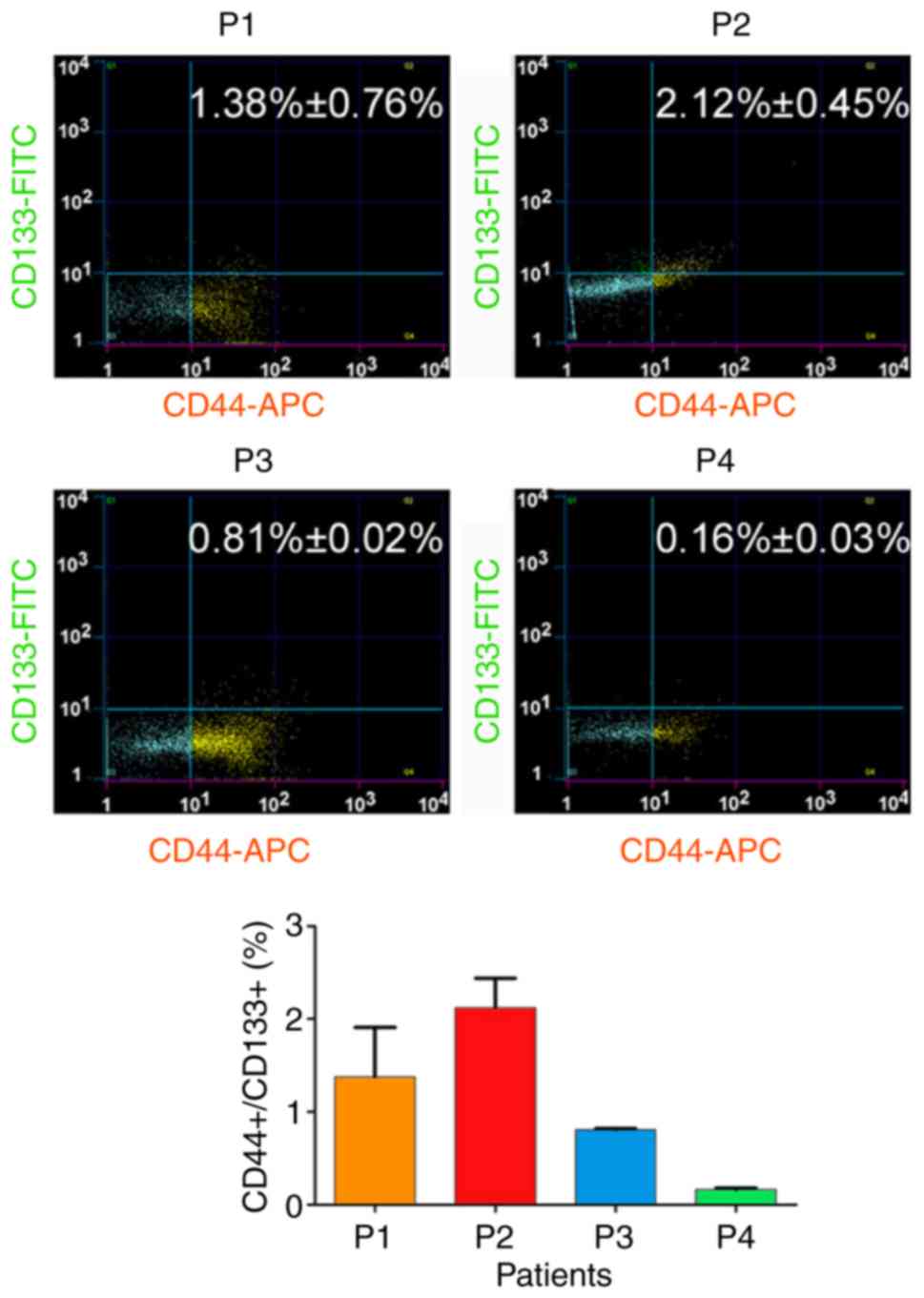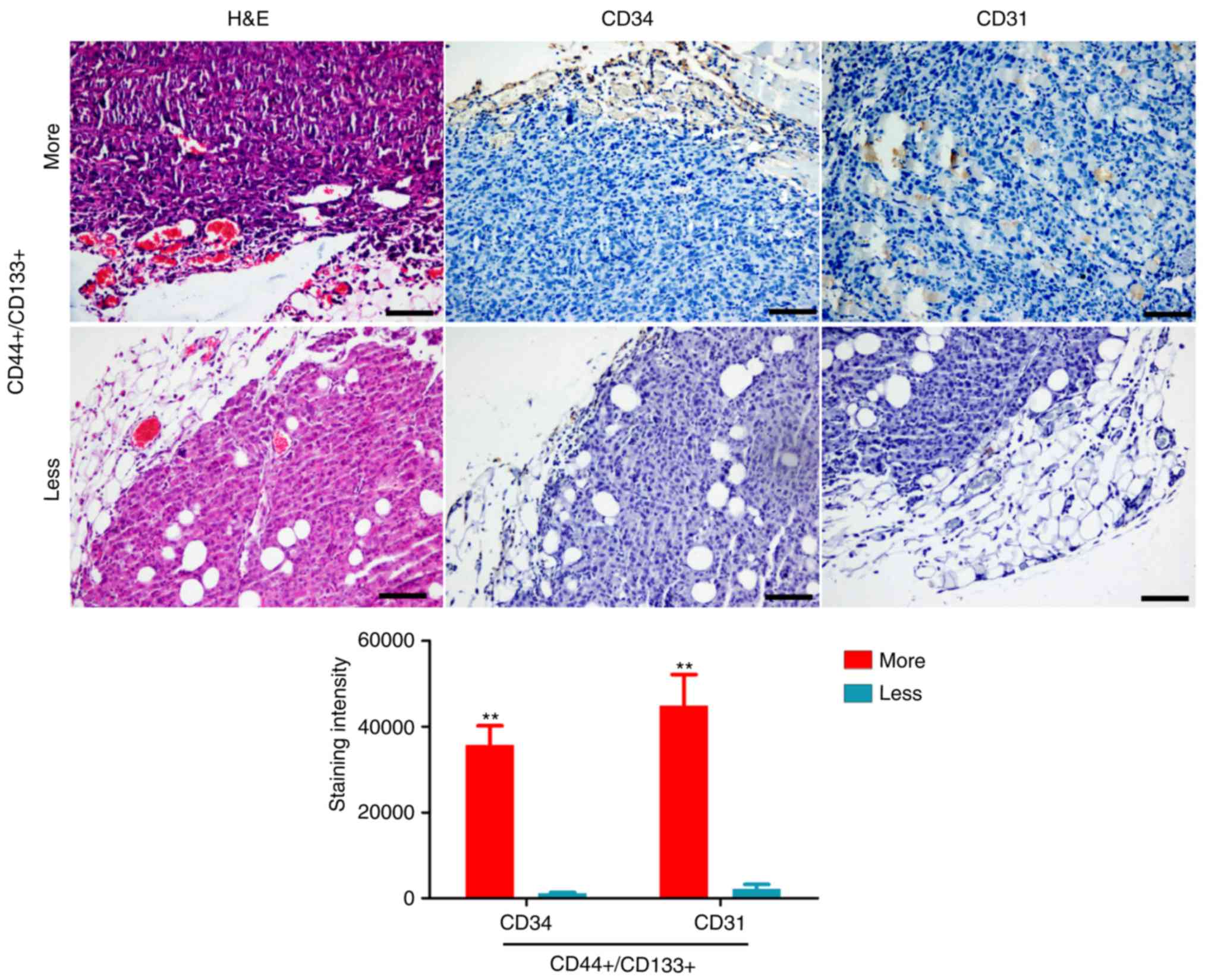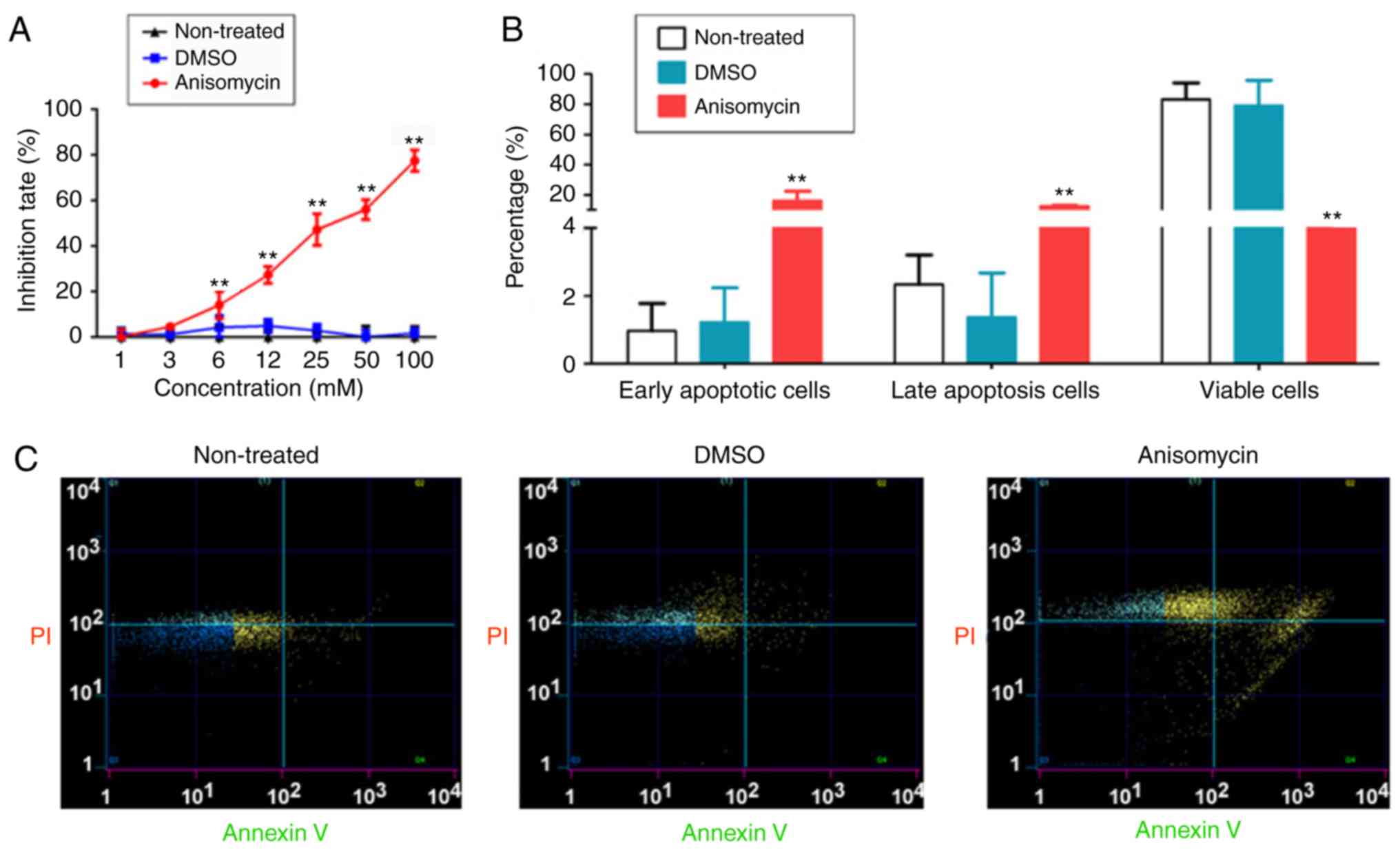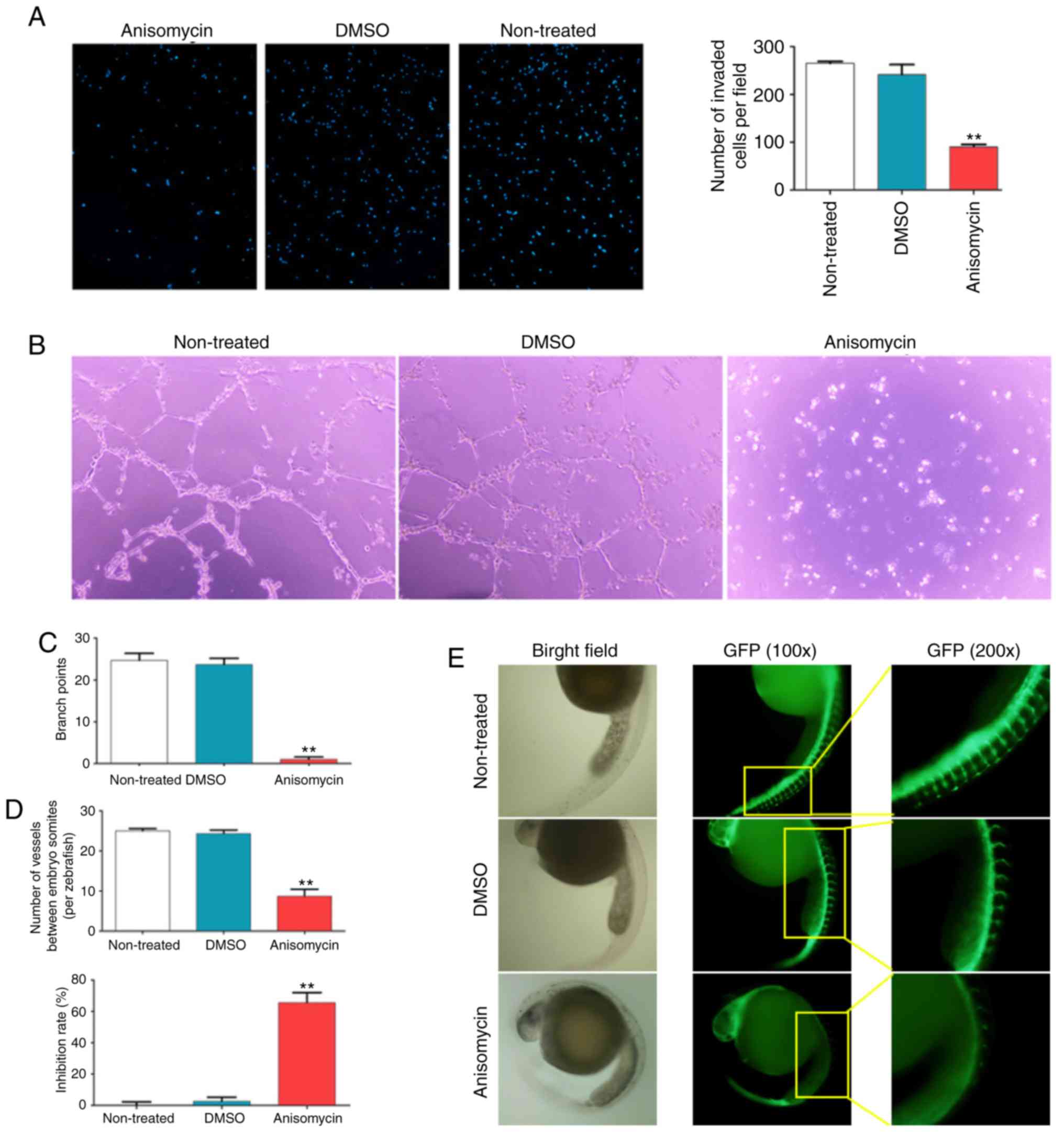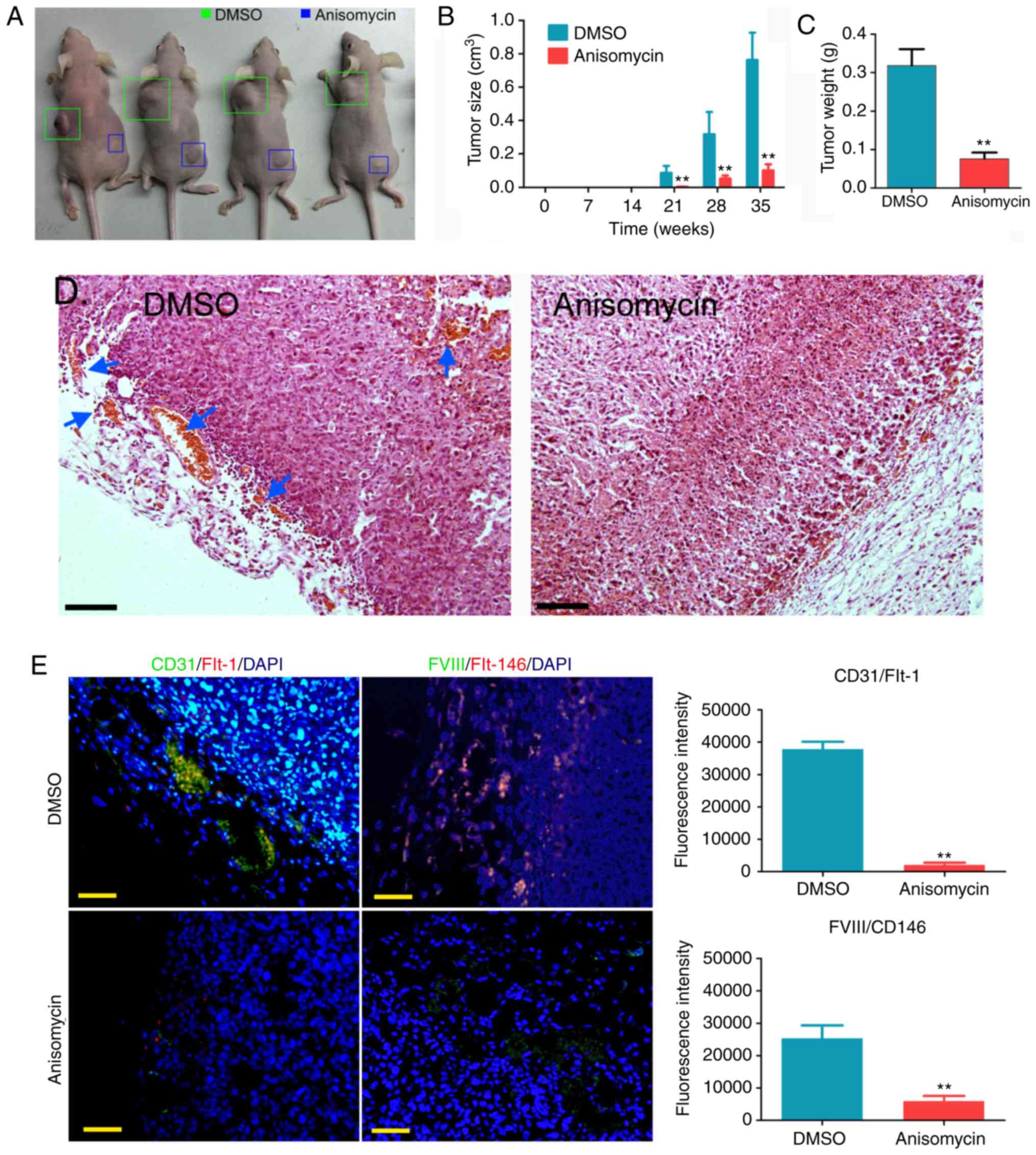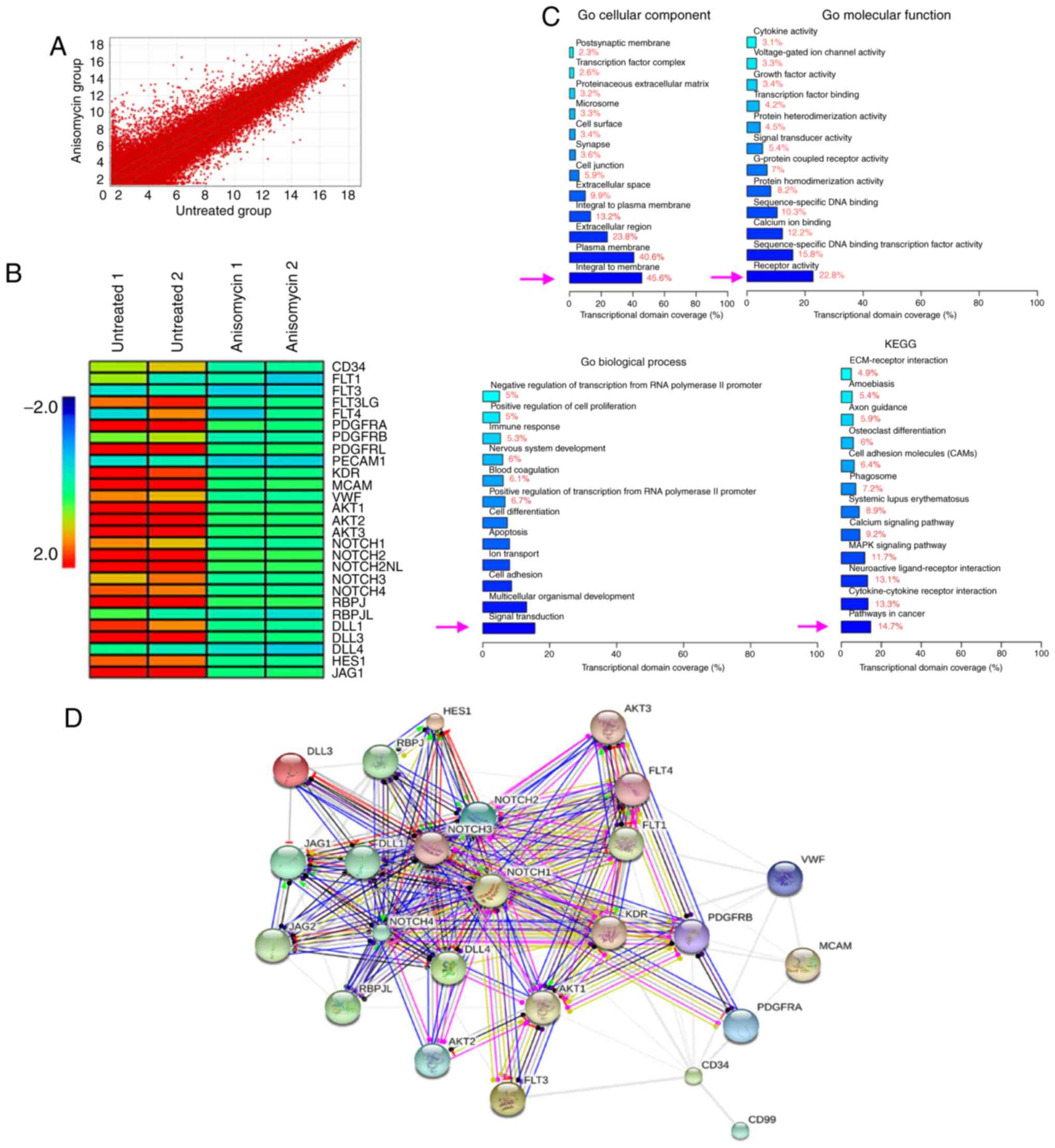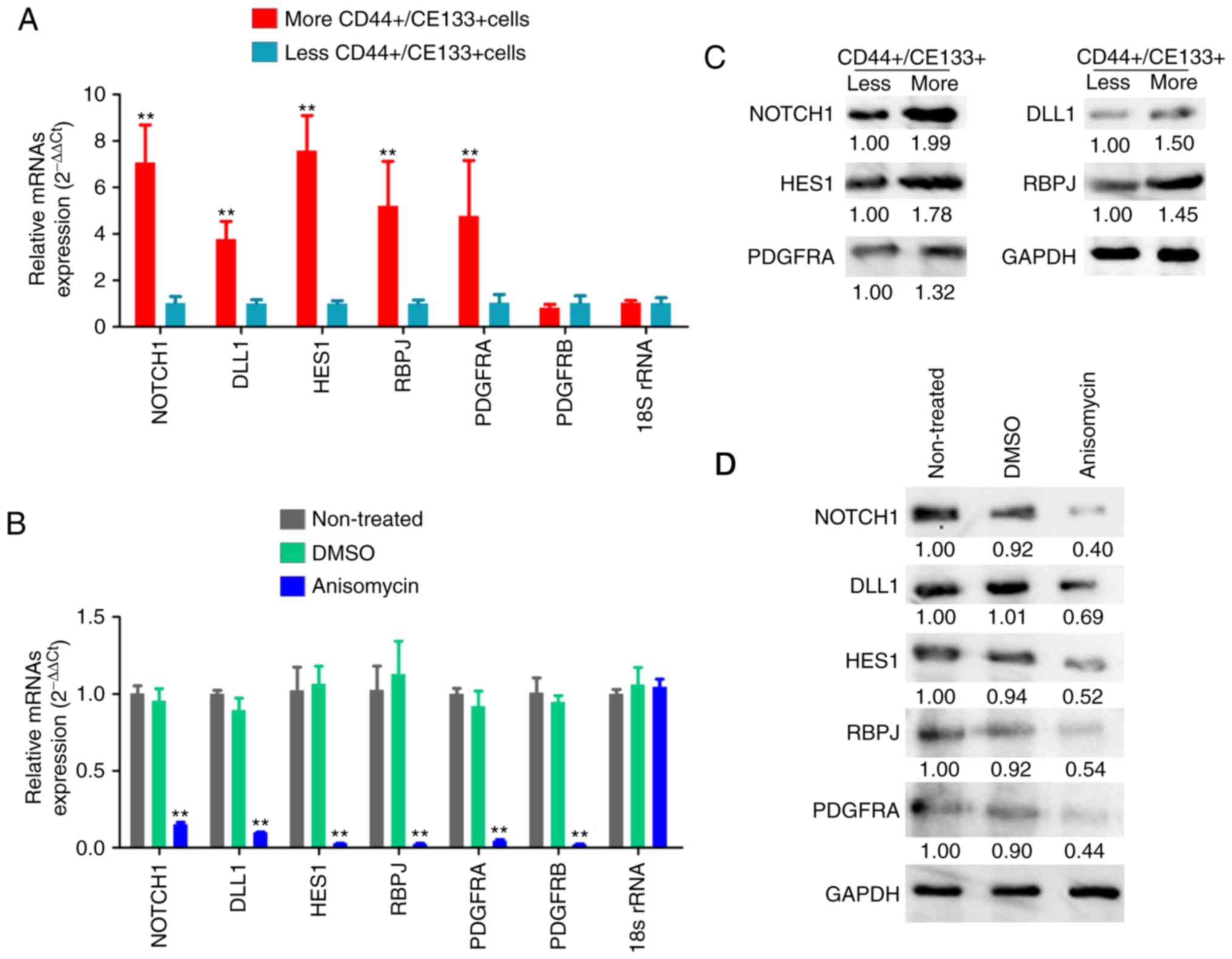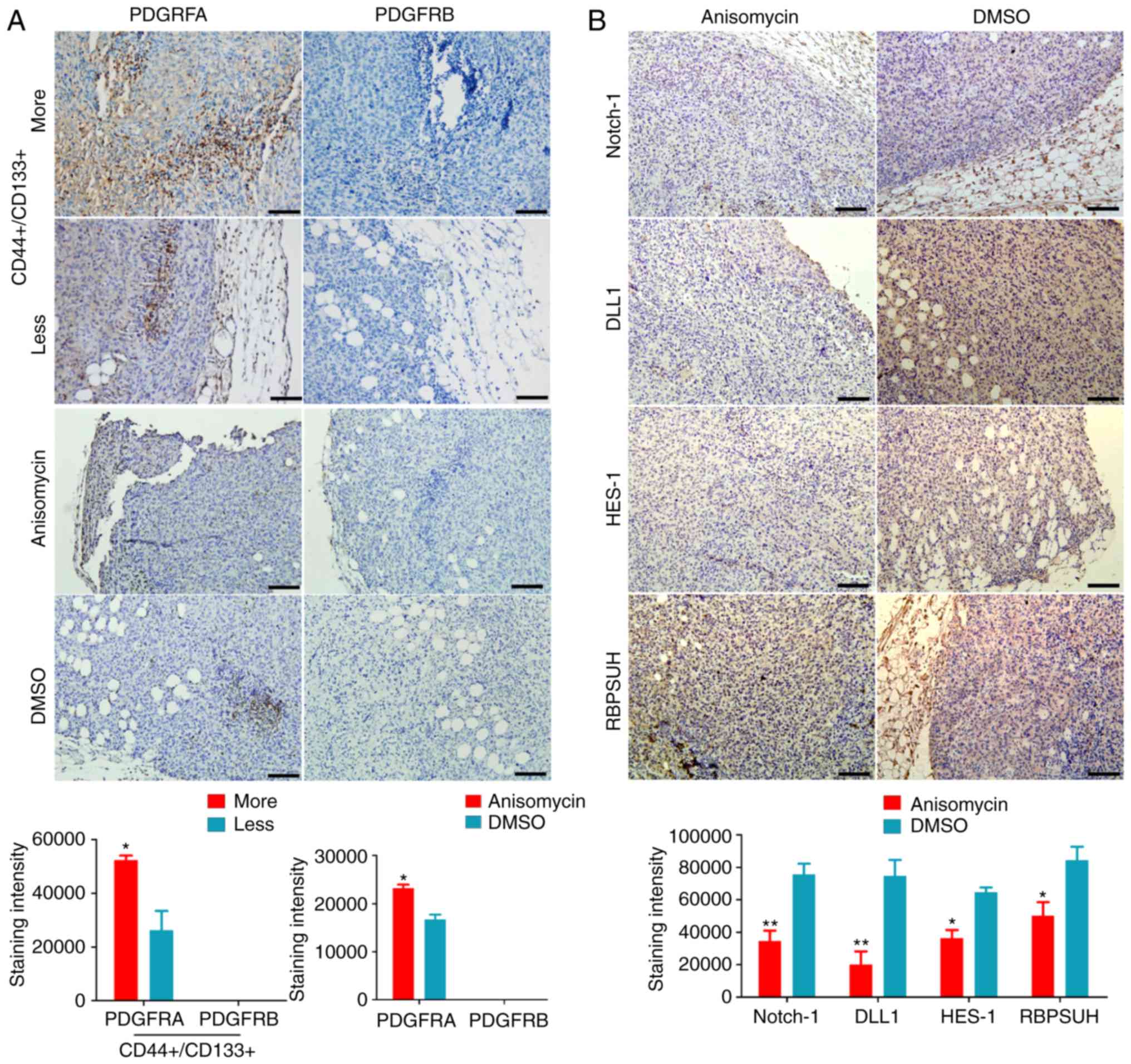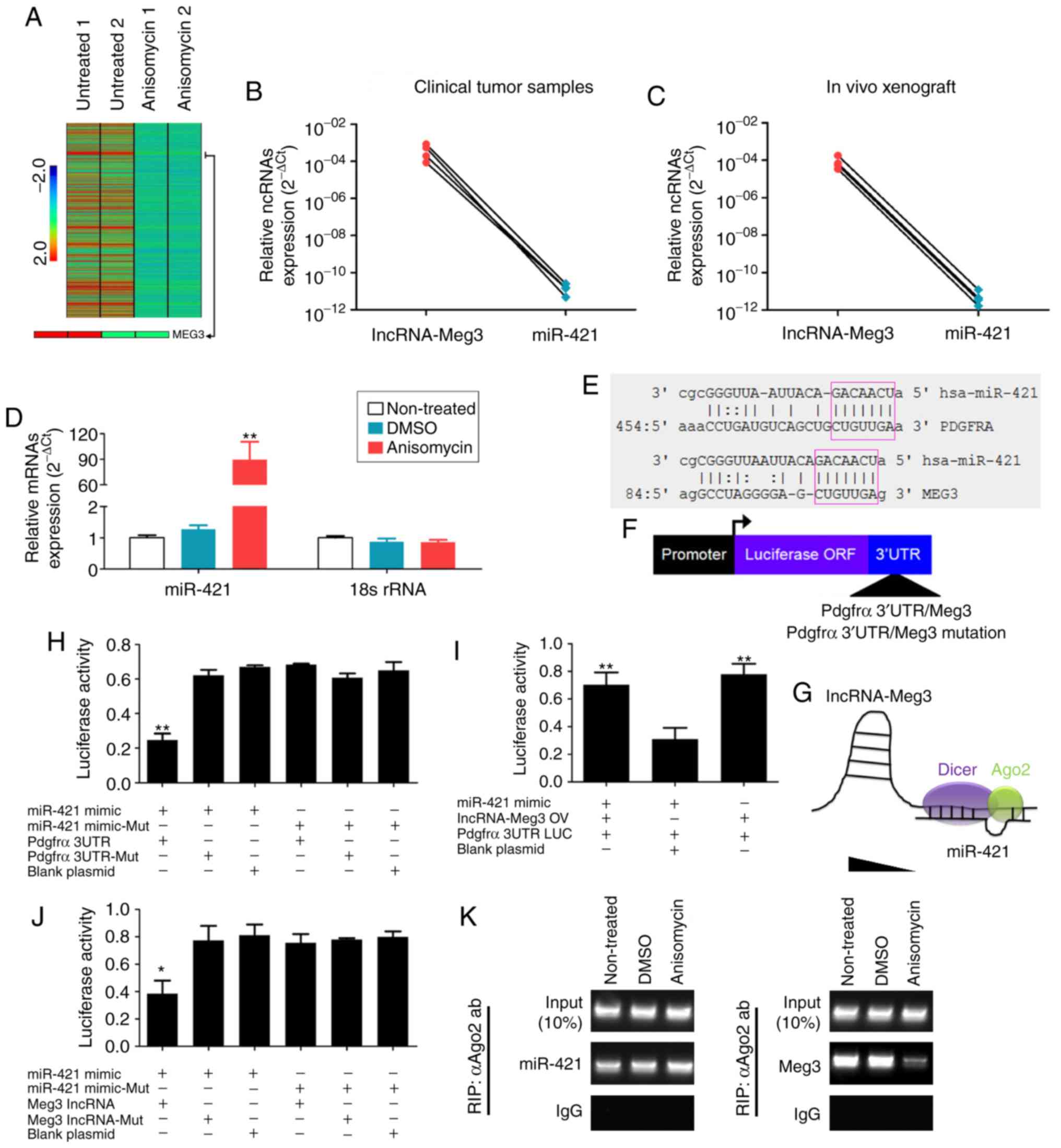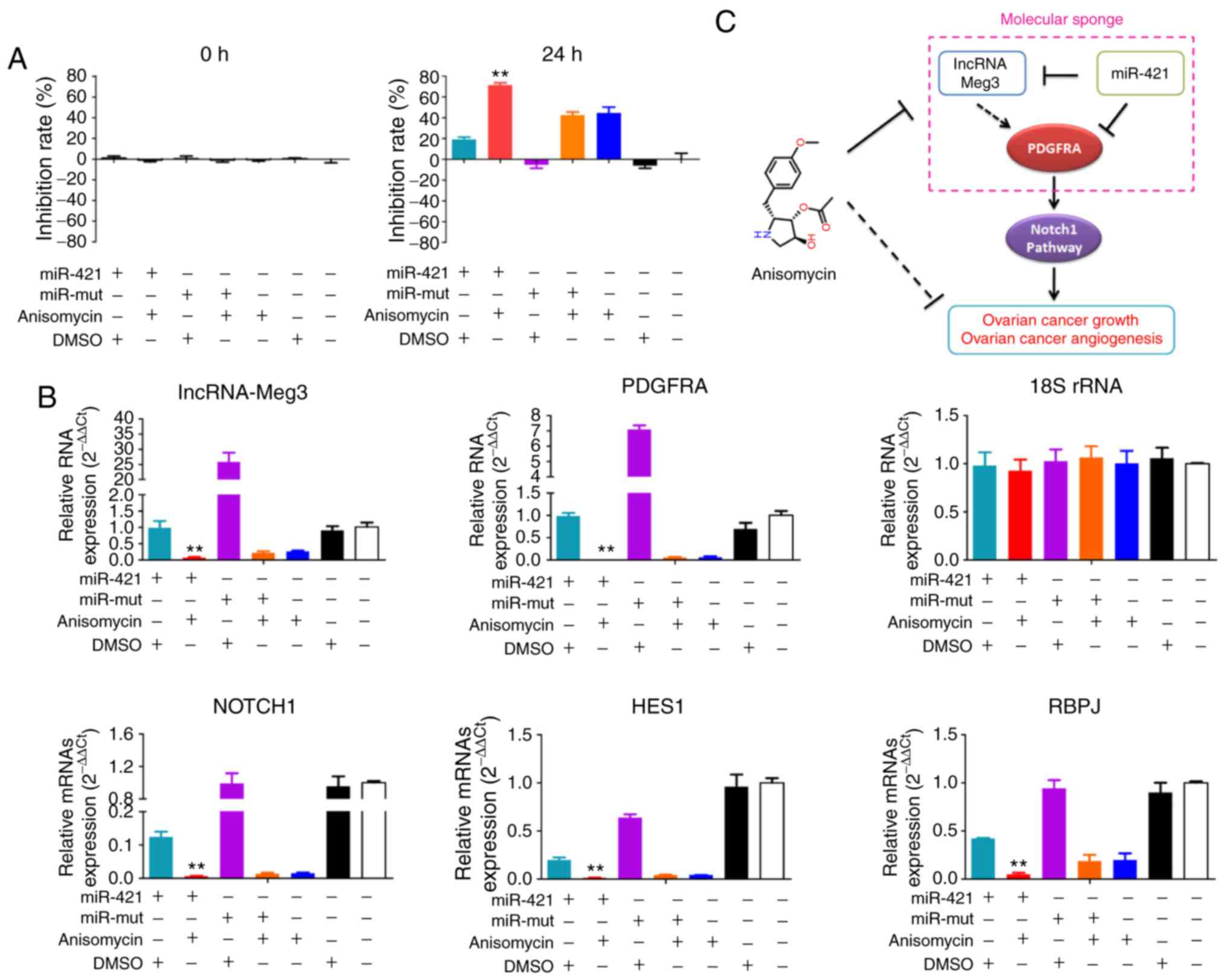|
1
|
Jain RK and Carmeliet P: SnapShot: Tumor
angiogenesis. Cell. 149:1408. e14012012. View Article : Google Scholar : PubMed/NCBI
|
|
2
|
Rivera LB and Bergers G: CANCER. Tumor
angiogenesis, from foe to friend. Science. 349:694–695. 2015.
View Article : Google Scholar : PubMed/NCBI
|
|
3
|
Melero-Martin JM and Dudley AC: Concise
review: Vascular stem cells and tumor angiogenesis. Stem Cells.
29:163–168. 2011. View Article : Google Scholar : PubMed/NCBI
|
|
4
|
Kuczynski EA, Vermeulen PB, Pezzella F,
Kerbel RS and Reynolds AR: Vessel co-option in cancer. Nat Rev Clin
Oncol. 16:469–493. 2019. View Article : Google Scholar : PubMed/NCBI
|
|
5
|
Ho IA, Toh HC, Ng WH, Teo YL, Guo CM, Hui
KM and Lam PY: Human bone marrow-derived mesenchymal stem cells
suppress human glioma growth through inhibition of angiogenesis.
Stem Cells. 31:146–155. 2013. View Article : Google Scholar
|
|
6
|
Apte RS, Chen DS and Ferrara N: VEGF in
signaling and disease: Beyond discovery and development. Cell.
176:1248–1264. 2019. View Article : Google Scholar : PubMed/NCBI
|
|
7
|
Chen Q, Liu X, Xu L, Wang Y, Wang S, Li Q,
Huang Y and Liu T: Long non-coding RNA BACE1-AS is a novel target
for anisomycin-mediated suppression of ovarian cancer stem cell
proliferation and invasion. Oncol Rep. 35:1916–1924. 2016.
View Article : Google Scholar : PubMed/NCBI
|
|
8
|
Li Y, Hu J, Song H and Wu T: Antibiotic
anisomycin selectively targets leukemia cell lines and patient
samples through suppressing Wnt/beta-catenin signaling. Biochem
Biophys Res Commun. 505:858–864. 2018. View Article : Google Scholar : PubMed/NCBI
|
|
9
|
Yu C, Xing F, Tang Z, Bronner C, Lu X, Di
J, Zeng S and Liu J: Anisomycin suppresses Jurkat T cell growth by
the cell cycle-regulating proteins. Pharmacol Rep. 65:435–444.
2013. View Article : Google Scholar : PubMed/NCBI
|
|
10
|
Seo BR, Min KJ, Kim S, Park JW, Park WK,
Lee TJ and Kwon TK: Anisomycin treatment enhances TRAIL-mediated
apoptosis in renal carcinoma cells through the down-regulation of
Bcl-2, c-FLIP(L) and Mcl-1. Biochimie. 95:858–865. 2013. View Article : Google Scholar
|
|
11
|
Liu Y, Ge J, Li Q, Gu L, Guo X, Ma ZG and
Zhu YP: Anisomycin induces apoptosis of glucocorticoid resistant
acute lymphoblastic leukemia CEM-C1 cells via activation of
mitogen-activated protein kinases p38 and JNK. Neoplasma.
60:101–110. 2013. View Article : Google Scholar
|
|
12
|
Liu T, Zhang H, Zheng J, Lin J, Huang Y,
Chen J, Yu Z, Guo L, Pan W, Xiong Y and Chen C: SPION-mediated
miR-141 promotes the differentiation of HuAESCs into dopaminergic
neuron-like cells via suppressing lncRNA-HOTAIR. J Cell Mol Med.
22:2299–2310. 2018. View Article : Google Scholar : PubMed/NCBI
|
|
13
|
Liu T, Chi H, Chen J, Chen C, Huang Y, Xi
H, Xue J and Si Y: Curcumin suppresses proliferation and in vitro
invasion of human prostate cancer stem cells by ceRNA effect of
miR-145 and lncRNA-ROR. Gene. 631:29–38. 2017. View Article : Google Scholar : PubMed/NCBI
|
|
14
|
Sarfi M, Abbastabar M and Khalili E: Long
noncoding RNAs biomarker-based cancer assessment. J Cell Physiol.
234:16971–16986. 2019. View Article : Google Scholar : PubMed/NCBI
|
|
15
|
Liu SJ and Lim DA: Modulating the
expression of long non-coding RNAs for functional studies. EMBO
Rep. 19:e469552018. View Article : Google Scholar : PubMed/NCBI
|
|
16
|
Zhu AD, Sun YY, Ma QJ and Xu F: lncRNA-ATB
promotes viability, migration, and angiogenesis in human
micro-vascular endothelial cells by sponging microRNA-195. J Cell
Biochem. 120:14360–14371. 2019. View Article : Google Scholar : PubMed/NCBI
|
|
17
|
Zhao J, Li L, Han ZY, Wang ZX and Qin LX:
Long noncoding RNAs, emerging and versatile regulators of
tumor-induced angiogenesis. Am J Cancer Res. 9:1367–1381.
2019.PubMed/NCBI
|
|
18
|
Sheng SR, Wu JS, Tang YL and Liang XH:
Long noncoding RNAs: Emerging regulators of tumor angiogenesis.
Future Oncol. 13:1551–1562. 2017. View Article : Google Scholar : PubMed/NCBI
|
|
19
|
Sun X, Huang T, Zhang C, Zhang S, Wang Y,
Zhang Q and Liu Z: Long non-coding RNA LINC00968 reduces cell
proliferation and migration and angiogenesis in breast cancer
through up-regulation of PROX1 by reducing hsa-miR-423-5p. Cell
Cycle. 18:1908–1924. 2019. View Article : Google Scholar : PubMed/NCBI
|
|
20
|
Cheng Y, Dai X, Yang T, Zhang N, Liu Z and
Jiang Y: Low long noncoding RNA growth arrest-specific transcript 5
expression in the exosomes of lung cancer cells promotes tumor
angiogenesis. J Oncol. 2019:24761752019. View Article : Google Scholar : PubMed/NCBI
|
|
21
|
Cheng W, Liu T, Wan X, Gao Y and Wang H:
MicroRNA-199a targets CD44 to suppress the tumorigenicity and
multidrug resistance of ovarian cancer-initiating cells. FEBS J.
279:2047–2059. 2012. View Article : Google Scholar : PubMed/NCBI
|
|
22
|
Zhang H, Zheng J, Lin J, Chen J, Yu Z,
Chen C and Liu T: miR-758 mediates oxLDL-dependent vascular
endothelial cell damage by suppressing the succinate receptor
SUCNR1. Gene. 663:1–8. 2018. View Article : Google Scholar : PubMed/NCBI
|
|
23
|
Livak KJ and Schmittgen TD: Analysis of
relative gene expression data using real-time quantitative PCR and
the 2(-Delta Delta C(T)) method. Methods. 25:402–408. 2001.
View Article : Google Scholar
|
|
24
|
Rodriguez-Hernandez A, Brea-Calvo G,
Fernandez-Ayala DJ, Cordero M, Navas P and Sanchez-Alcazar JA:
Nuclear caspase-3 and caspase-7 activation, and poly(ADP-ribose)
polymerase cleavage are early events in camptothecin-induced
apoptosis. Apoptosis. 11:131–139. 2006. View Article : Google Scholar
|
|
25
|
Si Y, Liu J, Shen H, Zhang C, Wu Y, Huang
Y, Gong Z, Xue J and Liu T: Fisetin decreases TET1 activity and
CCNY/CDK16 promoter 5hmC levels to inhibit the proliferation and
invasion of renal cancer stem cell. J Cell Mol Med. 23:1095–1105.
2019. View Article : Google Scholar :
|
|
26
|
Zhang H, Zheng J, Shen H, Huang Y, Liu T,
Xi H and Chen C: Curcumin suppresses in vitro proliferation and
invasion of human prostate cancer stem cells by modulating
DLK1-DIO3 imprinted gene cluster MicroRNAs. Genet Test Mol
Biomarkers. 22:43–50. 2018. View Article : Google Scholar
|
|
27
|
Fang K, Liu P, Dong S, Guo Y, Cui X, Zhu
X, Li X, Jiang L, Liu T and Wu Y: Magnetofection based on
superparamagnetic iron oxide nanoparticle-mediated low lncRNA
HOTAIR expression decreases the proliferation and invasion of
glioma stem cells. Int J Oncol. 49:509–518. 2016. View Article : Google Scholar : PubMed/NCBI
|
|
28
|
Liu T, Xu F, Du X, Lai D, Liu T, Zhao Y,
Huang Q, Jiang L, Huang W, Cheng W and Liu Z: Establishment and
characterization of multi-drug resistant, prostate
carcinoma-initiating stem-like cells from human prostate cancer
cell lines 22RV1. Mol Cell Biochem. 340:265–273. 2010. View Article : Google Scholar : PubMed/NCBI
|
|
29
|
Shao Y, Zhang L, Cui L, Lou W, Wang D, Lu
W, Jin D and Liu T: LIN28B suppresses microRNA let-7b expression to
promote CD44+/LIN28B+ human pancreatic cancer stem cell
proliferation and invasion. Am J Cancer Res. 5:2643–2659.
2015.PubMed/NCBI
|
|
30
|
Gao Y, Liu T and Huang Y: MicroRNA-134
suppresses endometrial cancer stem cells by targeting POGLUT1 and
Notch pathway proteins. FEBS Lett. 589:207–214. 2015. View Article : Google Scholar
|
|
31
|
Qin W, Xiong Y, Chen J, Huang Y and Liu T:
DC-CIK cells derived from ovarian cancer patient menstrual blood
activate the TNFR1ASK1-AIP1 pathway to kill autologous ovarian
cancer stem cells. J Cell Mol Med. 22:3364–3376. 2018. View Article : Google Scholar : PubMed/NCBI
|
|
32
|
Williams LT: Signal transduction by the
platelet-derived growth factor receptor. Science. 243:1564–1570.
1989. View Article : Google Scholar : PubMed/NCBI
|
|
33
|
Hoch RV and Soriano P: Roles of PDGF in
animal development. Development. 130:4769–4784. 2003. View Article : Google Scholar : PubMed/NCBI
|
|
34
|
Heldin CH: Targeting the PDGF signaling
pathway in tumor treatment. Cell Commun Signal. 11:972013.
View Article : Google Scholar : PubMed/NCBI
|
|
35
|
Chen H, Gu X, Liu Y, Wang J, Wirt SE,
Bottino R, Schorle H and Sage J: Kim SK. PDGF signalling controls
age-dependent proliferation in pancreatic β-cells. Nature.
478:349–355. 2011. View Article : Google Scholar : PubMed/NCBI
|
|
36
|
Choi MH, Lee IK, Kim GW, Kim BU, Han YH,
Yu DY, Park HS, Kim KY, Lee JS, Choi C, et al: Regulation of PDGF
signalling and vascular remodelling by peroxiredoxin II. Nature.
435:347–353. 2005. View Article : Google Scholar : PubMed/NCBI
|
|
37
|
Tam WL, Lu H, Buikhuisen J, Soh BS, Lim E,
Reinhardt F, Wu ZJ, Krall JA, Bierie B, Guo W, et al: Protein
kinase C α is a central signaling node and therapeutic target for
breast cancer stem cells. Cancer Cell. 24:347–364. 2013. View Article : Google Scholar : PubMed/NCBI
|
|
38
|
Wieland E, Rodriguez-Vita J, Liebler SS,
Mogler C, Moll I, Herberich SE, Espinet E, Herpel E, Menuchin A,
Chang-Claude J, et al: Endothelial notch1 activity facilitates
metastasis. Cancer Cell. 31:355–367. 2017. View Article : Google Scholar : PubMed/NCBI
|
|
39
|
Ramasamy SK, Kusumbe AP, Wang L and Adams
RH: Endothelial Notch activity promotes angiogenesis and
osteo-genesis in bone. Nature. 507:376–380. 2014. View Article : Google Scholar : PubMed/NCBI
|
|
40
|
Wang M, Mao C, Ouyang L, Liu Y, Lai W, Liu
N, Shi Y, Chen L, Xiao D, Yu F, et al: Long noncoding RNA LINC00336
inhibits ferroptosis in lung cancer by functioning as a competing
endogenous RNA. Cell Death Differ. 2019.Epub ahead of print.
View Article : Google Scholar
|
|
41
|
Luan W, Zhang X, Ruan H, Wang J and Bu X:
Long noncoding RNA OIP5-AS1 acts as a competing endogenous RNA to
promote glutamine catabolism and malignant melanoma growth by
sponging miR-217. J Cell Physiol. 2019.Epub ahead of print.
View Article : Google Scholar
|
|
42
|
Xu TP, Ma P, Wang WY, Shuai Y, Wang YF, Yu
T, Xia R and Shu YQ: KLF5 and MYC modulated LINC00346 contributes
to gastric cancer progression through acting as a competing
endogeous RNA and indicates poor outcome. Cell Death Differ.
2019.Epub ahead of print. View Article : Google Scholar
|
|
43
|
Dong H, Hu J, Zou K, Ye M, Chen Y, Wu C,
Chen X and Han M: Activation of LncRNA TINCR by H3K27 acetylation
promotes trastuzumab resistance and epithelial-mesenchymal
transition by targeting MicroRNA-125b in breast cancer. Mol Cancer.
18:32019. View Article : Google Scholar : PubMed/NCBI
|
|
44
|
Wu XS, Wang F, Li HF, Hu YP, Jiang L,
Zhang F, Li ML, Wang XA, Jin YP, Zhang YJ, et al: LncRNA-PAGBC acts
as a microRNA sponge and promotes gallbladder tumorigenesis. EMBO
Rep. 18:1837–1853. 2017. View Article : Google Scholar : PubMed/NCBI
|
|
45
|
Zhang X, Wu N, Wang J and Li Z: LncRNA
MEG3 inhibits cell proliferation and induces apoptosis in laryngeal
cancer via miR-23a/APAF-1 axis. J Cell Mol Med. 2019.Epub ahead of
print.
|
|
46
|
Joglekar-Javadekar M, Van Laere S, Bourne
M, Moalwi M, Finetti P, Vermeulen PB, Birnbaum D, Dirix LY, Ueno N,
Carter M, et al: Characterization and targeting of platelet-derived
growth factor receptor alpha (PDGFRA) in inflammatory breast cancer
(IBC). Neoplasia. 19:564–573. 2017. View Article : Google Scholar : PubMed/NCBI
|
|
47
|
Ong HS, Gokavarapu S, Tian Z, Li J, Xu Q,
Cao W and Zhang CP: PDGFRA mRNA is overexpressed in oral cancer
patients as compared to normal subjects with a significant trend of
overexpression among tobacco users. J Oral Pathol Med. 46:591–597.
2017. View Article : Google Scholar : PubMed/NCBI
|
|
48
|
Gao S, Li E and Gao H: Long non-coding RNA
MEG3 attends to morphine-mediated autophagy of HT22 cells through
modulating ERK pathway. Pharm Biol. 57:536–542. 2019. View Article : Google Scholar : PubMed/NCBI
|
|
49
|
Binabaj MM, Bahreyni A, Khazaei M, Avan A
and Hassanian SM: The prognostic value of long noncoding RNA MEG3
expression in the survival of patients with cancer: A
meta-analysis-response. J Cell Biochem. 2019.Epub ahead of print.
View Article : Google Scholar : PubMed/NCBI
|
|
50
|
Meng Q, Li S, Liu Y, Zhang S, Jin J, Zhang
Y, Guo C, Liu B and Sun Y: Circular RNA circSCAF11 accelerates the
glioma tumorigenesis through the miR-421/SP1/VEGFA axis. Mol Ther
Nucleic Acids. 17:669–677. 2019.Epub ahead of print. View Article : Google Scholar : PubMed/NCBI
|
|
51
|
Li Y, Han X, Li Q, Wang C, Lou Z and Wang
X: Long noncoding RNA HOXD-AS1 induces epithelial-mesenchymal
transition in breast cancer by acting as a competing endogenous RNA
of miR-421. J Cell Biochem. 120:10633–10642. 2019. View Article : Google Scholar : PubMed/NCBI
|
|
52
|
Yin Y, Xu L, Chang Y, Zeng T, Chen X, Wang
A, Groth J, Foo WC, Liang C, Hu H and Huang J: N-Myc promotes
therapeutic resistance development of neuroendocrine prostate
cancer by differentially regulating miR-421/ATM pathway. Mol
Cancer. 18:112019. View Article : Google Scholar : PubMed/NCBI
|















